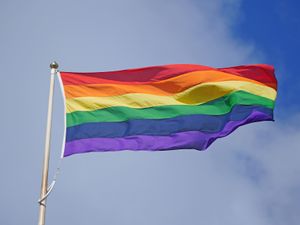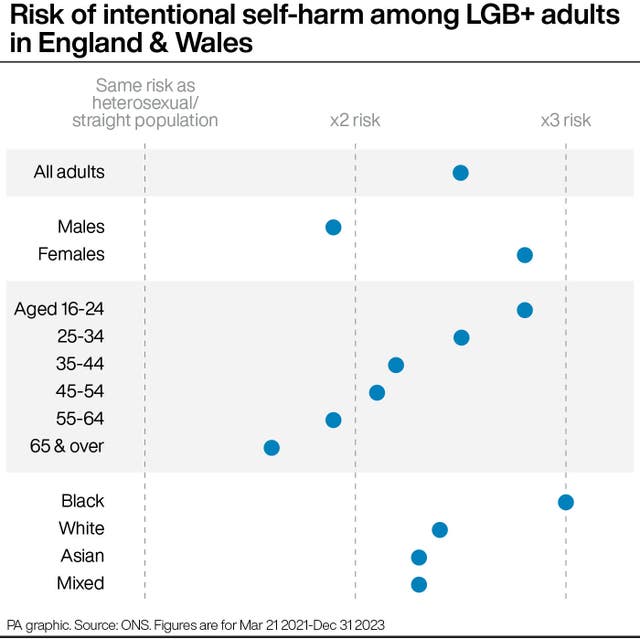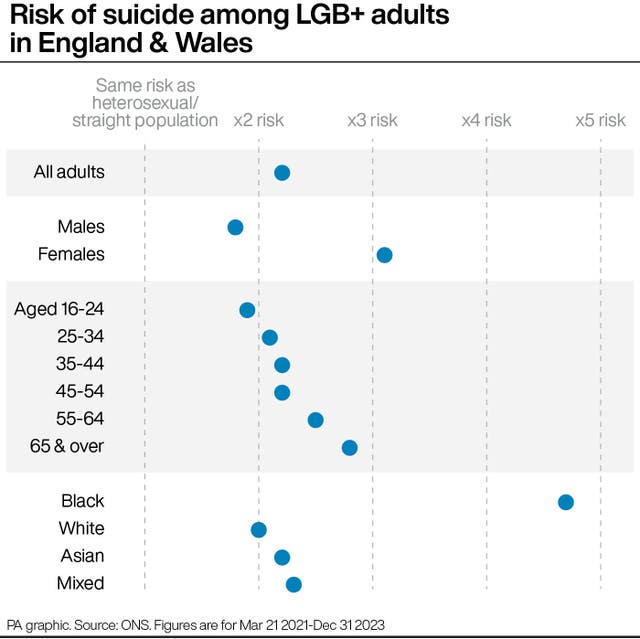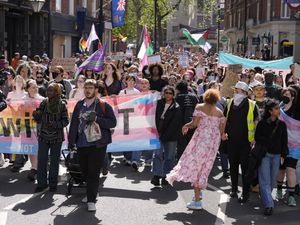People identifying as LGB+ ‘at higher risk’ of self-harm or suicide
The risk of suicide for LGB+ adults is estimated to be 2.2 times higher than for those identifying as straight or heterosexual.

People identifying as lesbian, gay or another sexual orientation (LGB+) are at higher risk of intentional self-harm or suicide than those who describe themselves as straight or heterosexual, new figures suggest.
The risk is “particularly high” for people in the LGB+ community who are female or from a black ethnic group, while for self-harm there is an elevated risk for 16 to 24-year-olds.
Charity group Samaritans said that while publication of the data is an important step forward for suicide prevention, it paints “a bleak picture that demands action”.

The findings are part of new analysis by the Office for National Statistics (ONS) that explores for the first time how estimated rates of self-harm and suicide differ by sexual orientation.
Data on sexuality recorded in the 2021 census has been linked with NHS hospital records and death registrations for adults in England and Wales for the period March 2021 to December 2023.
The ONS found the risk of suicide for people aged 16 and over identifying as LGB+ was estimated to be 2.2 times higher than for those identifying as straight or heterosexual, while the risk of intentional self-harm was 2.5 times higher.
Figures for self-harm were based on hospital admissions and A&E attendances, while death registrations were used for instances of suicide.
The age-standardised rate of intentional self-harm for adults identifying as LGB+ was 1,508.9 per 100,000 people, compared with 598.4 per 100,000 for those saying they were straight or heterosexual.
The rate of suicide among LGB+ adults stood at 50.3 per 100,000 people, compared with 23.1 per 100,000 for those describing themselves as straight or heterosexual.
Emma Sharland, of the ONS health research group, said: “This is our first analysis of intentional self-harm and suicide by sexual orientation, giving new insights to this important topic.
“Our analysis highlights groups within the LGB+ community where the relative risk of intentional self-harm or suicide is particularly high compared with their straight or heterosexual counterparts.
“For self-harm this includes females, younger adults and those from a black ethnic group.
“For suicides we also see this elevated risk in females, older adults and those from a black ethnic group.
“Every death by suicide is a tragedy and has a devastating impact on family, friends and communities and we hope today’s analysis will provide valuable insight for those concerned with self-harm and suicide prevention.”
Both females and males identifying as LGB+ had a “statistically significant” higher risk of intentional self-harm than those describing themselves as straight or heterosexual, the analysis found.
The risk was 2.8 times higher for females and 1.9 times higher for males.
It was 2.8 times higher for LGB+ 16 to 24-year-olds, more than any other age group, though all ages had a statistically significant elevated risk, including people aged 65 and over (1.6 times higher).
Within the LGB+ population, the risk of self-harm was 3.0 times higher for people identifying as black, a larger relative increase than for white (2.4 times higher), Asian (2.3) and mixed (2.3) ethnic groups; 2.9 times higher for those in living in the least deprived areas and 2.4 in the most deprived; and 2.9 times higher in rural areas, compared with 2.5 for urban areas.
Jacqui Morrissey, assistant director of influencing at Samaritans, described the findings as “a bleak picture that demands action”, adding: “These figures must now force the Government to address this inequality issue before more lives are lost.

“While this data being published for the first time is a hugely important step forward for suicide prevention, we know the full picture is incomplete.
“Barriers still exist to people feeling able to disclose their sexual orientation, while a significant number of people who self-harm don’t attend hospital, so sadly the reality could be even starker.
“Urgent action is needed across healthcare to tackle the barriers that LGBTQ+ people face to getting the support they really need.
“Government can no longer drag its feet; lives depend on getting this right.”
Risk of suicide among people identifying as LGB+ was 3.1 times higher for females and 1.8 times higher for males – again, statistically significant relative increases compared with the heterosexual population.
When looking at age groups, the ONS found an opposite pattern to that seen for the risk of self-harm, with the increase in risk of suicide highest among LGB+ people aged 65 and over (2.8 times higher) and lowest for 16 to 24-year-olds (1.9 times higher).
The risk of suicide among black LGB+ adults was 4.7 times higher than for the equivalent group in the heterosexual population, a sharper relative increase than for adults of Asian (2.2), white (2.0) and mixed (2.3) ethnic backgrounds.
The ONS noted it “cannot say” why rates of intentional self-harm and suicide for people who identify as LGB+ differ to those for people who identify as heterosexual, adding: “It is not possible to say whether sexual orientation is a causal risk factor for intentional self-harm or suicide.”
If you are struggling to cope, please call Samaritans free of charge on 116 123 (UK and Republic of Ireland).
Other sources of support are listed on the NHS help for suicidal thoughts webpage.
Support is available around the clock, every day of the year.
An NHS spokesperson said: “The NHS is here for everyone and if people in the LGB+ community are suffering and need mental health support, there are variety of ways that we can help.
“There are talking therapies, which you can self-refer for or speak with your GP to enrol in, or there is crisis support available 24/7, 365 days a year, through NHS 111.
“Please do not hesitate to come forward if you need help.”





